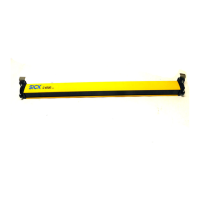Operating Instructions Chapter 4
C4000 Micro/Basic/Basic Plus/Eco
8009423/YT79/2016-03-14 © SICK AG • Industrial Safety Systems • Germany • All rights reserved 21
Subject to change without notice
Installation and mounting
How to calculate the safety distance D
s
according to ANSI B11.19:2003-04, Annex D
and Code of Federal Regulations, Volume 29, Part 1910.217 … (h) (9) (v):
The following calculation shows an example calculation of the safety distance. Depending
on the application and the ambient conditions, a different calculation may be necessary.
⋅ Calculate D
s
using the following formula:
D
s
= H
s
× (T
s
+ T
c
+T
r
+ T
bm
) + D
pf
Where …
D
s
= The minimum distance in inches (or millimetres) from the hazardous point to the
protective device
H
s
= A parameter in inches/second or millimetres/second, derived from data on
approach speeds of the body or parts of the body. Often 63 inches/second
(1600 millimetres/second) is used for H
s
.
T
s
= Stopping/run down time of the machine tool measured at the final control
element
T
c
= Stopping/run-down time of the control system
T
r
= Response time of the entire protective device after light path interruption
T
bm
= Additional response time allowed for brake monitor to compensate for wear
Any additional response times must be accounted for in this calculation.
D
pf
= An additional distance added to the overall safety distance required. This value is
based on intrusion toward the hazardous point prior to actuation of the electro-
sensitive protective equipment (ESPE). Values range from 0.25 inches to 48 in-
ches (6 millimetres to 1220 millimeters) or more depending on application.
Example:
In opto-electronic protecting, such as with a perpendicular safety light curtain
applications with object sensitivity (effective resolution) less than 2.5 inches
(64 millimetres), the D
pf
can be approximated based on the following formula:
D
pf
(inches) = 3.4 × (Object Sensitivity – 0.276), but not less than 0.
Note
Note

